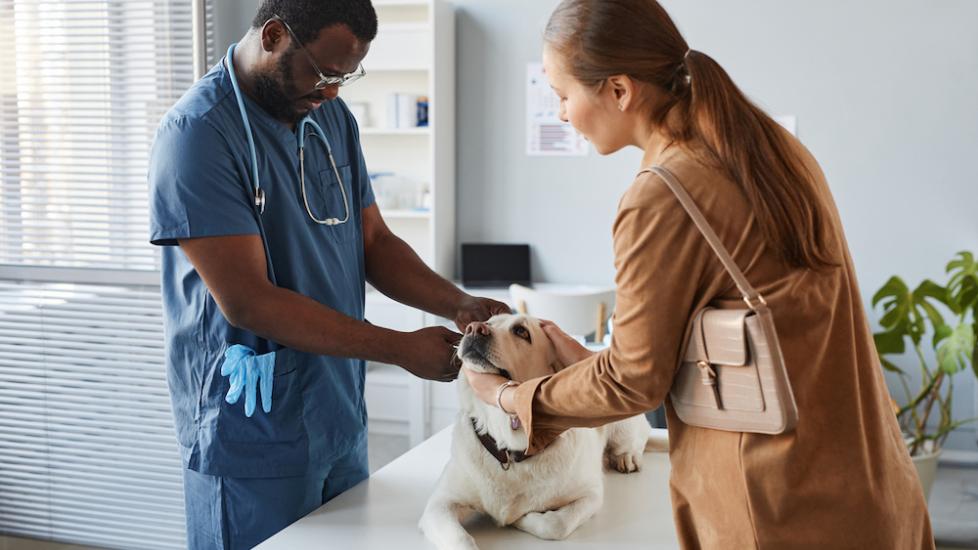Seasonal Flank Alopecia in Dogs
What Is Seasonal Flank Alopecia in Dogs?
Seasonal flank alopecia is a skin condition that occurs in dogs. The flanks on a dog refer to the side areas behind the chest and in front of the legs, and alopecia means the loss of hair. In seasonal flank alopecia, there are patches of hair loss along either or both sides of the dog. This is typically during the winter, but it can occur during other months.
Although hair loss can start in different months, most commonly the onset is between November and March in the Northern Hemisphere because of reduced daylight, with hair regrowth occurring spontaneously three to eight months later.
Other than the hair loss itself, the condition does not cause the dog discomfort, itchiness, or irritation. In some dogs, repeated episodes will result in an increase in hair loss and longer time until the hair regrows.
Health Tools
Not sure whether to see a vet?
Symptoms of Seasonal Flank Alopecia in Dogs
-
Hair loss on either or both sides of the dog
-
Areas of hair loss can be even or uneven on both sides
-
Areas of hair loss are well defined
-
In the areas of hair loss, the skin will sometimes become darker (hyperpigmented)
-
Hair loss occurs in cycles
Causes of Seasonal Flank Alopecia in Dogs
Unfortunately, there is no known cause for the condition, but research shows that it is likely related to the shorter days and longer nights that occur during the fall and winter months. Because of the shortened days, hormonal changes (such as melatonin and prolactin) would normally trigger the growth of a thick, winter coat. However, in dogs with seasonal flank alopecia, this does not happen.
Typically, the condition is first seen in dogs 1 to 6 years old, and will continue throughout the dog’s life. The most affected breeds are Boxers, English Bulldogs, Airedale Terriers, and Schnauzers, but it can be seen in any pure or mixed breed.
How Veterinarians Diagnose Seasonal Flank Alopecia in Dogs
In recurring cases, the diagnosis is relatively simple based on history; however, it’s important to rule out other diseases first. Your vet may want to rule out other conditions such as skin infections (pyoderma), demodectic mange, ringworm (dermaphytosis), endocrine disorders such as hypothyroidism, and Cushing’s disease.
If the dog’s history is unknown, or to definitively confirm the diagnosis, your vet may want to perform a skin biopsy. This involves having your pet sedated and given a local pain blocker. A small area of skin will be removed and sent to a lab for a board-certified veterinary pathologist to examine. Using a microscope, they’re looking for characteristic patterns such as abnormal and reduced growth of hair follicles filled with keratin and a classic “branching” pattern.
Treatment of Seasonal Flank Alopecia in Dogs
Since dogs with this condition are otherwise healthy—and because it’s a cosmetic condition, most dogs will only need to be observed over time. This is to ensure symptoms are not getting worse or there are additional symptoms along with the hair loss.
Melatonin is typically the treatment of choice. A critical aspect in successful treatment is starting melatonin one month prior to the expected time of hair loss (before the onset of winter). Melatonin can be given orally or as a compounded injection. There is also a third option, a melatonin implant. But some dogs can have an adverse reaction, causing an abscess on their skin.
Chat with your veterinarian or board-certified veterinary dermatologist for recommendations on oral melatonin. Supplements are not regulated by the US Food and Drug Administration (FDA), which means there can be a difference in its effectiveness.
Recovery and Management of Seasonal Flank Alopecia in Dogs
The outlook for hair regrowth can vary. In some dogs, hair completely regrows. But other dogs may have incomplete regrowth, or a different color and texture of hair in the affected area.
Hair regrowth can start spontaneously about three to eight months after hair loss starts, but the cyclical pattern is variable between animals. As the hair loss cycle becomes obvious, treatment can be started about a month prior to the anticipated hair loss.
Seasonal Flank Alopecia in Dogs FAQs
How long does seasonal flank alopecia last?
In most cases, seasonal flank alopecia will last during winter months, and as the days start to lengthen, it can self-resolve; however, there are cases where dogs will continue to cycle, and around age 6 or 7 will have progressively less hair regrowth due to age.
Is seasonal flank alopecia painful for dogs?
Seasonal flank alopecia should not cause any discomfort or irritation; it is a cosmetic disease that does not affect the dog’s quality of life.
Featured Image: iStock.com/SeventyFour
References
VM 534. Seasonal Flank Alopecia. MSU MediaSpace. 2020.
Brooks, W. Veterinary Partner. VIN.com. Seasonal Flank Alopecia in Dogs. 2009.
Ettinger SJ, Feldman EC. Textbook of Veterinary Internal Medicine - EBook. Saunders; 2009.
